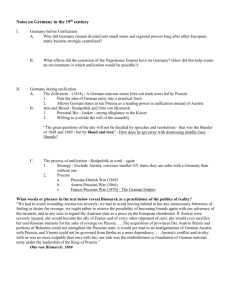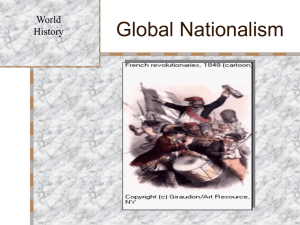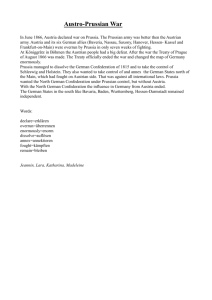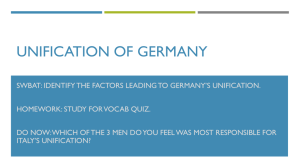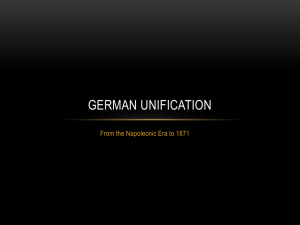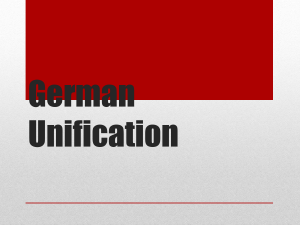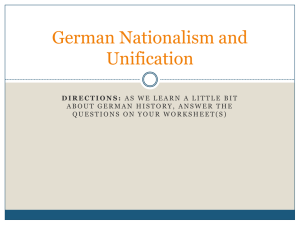12. Unification of Germany
advertisement
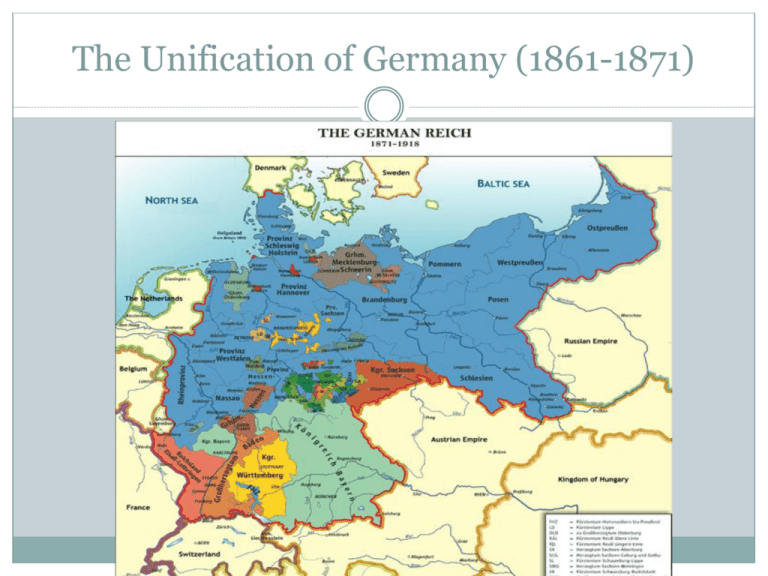
The Unification of Germany (1861-1871) Forces Against Unity in Germany Cultural differences within the German states : Protestant and Catholics; rural and urban livelihood; conservative and liberal Long history of independence of German states and princes Hapsburg Austria and France opposed German unification Prussian Leadership After Frankfurt Assembly failure in 1848, leadership for German unification passed to Prussia and the Hohenzollern kings Strongest military in German states Established the Zollverein—a large, free trade zone within German states Economically unified already Support for unification came from the Junkers (nobility) Unification will be achieved through force The Main Players of German Unification Otto von Bismarck Class “by blood and iron” Preferred gov’t Reason behind Iron Chancellor Wilhelm I Helmuth von Moltke Main Players William (Wilhelm) I—King of Prussia (1861) Wanted to enlarge the army, but lacked support from the liberal Prussian parliament 1861—King of Prussia 1871—Emperor of Germany Supported unification of Germany minus Austria Otto von Bismarck Appointed as Chancellor of Prussia in 1862 Junker Ignored the parliament and enlarged and reformed the army Built railroads for transportation of soldiers Worked to isolate Austria from the German Confederation “Blood and Iron” speech—unification will occur only through force Realpolitik—German emphasis on law, order, and hard work Wars of Unification Refer to your handout, identify in your notebook the three wars fought during the unification process and what each war accomplished. The Danish War (1864) no space Space before Austro-Prussian War (1866) Result: Creation of North German Confederation and contents no space Space before Franco-Prussian War (1870-1871) Bismarck’s Wars and Government The Danish War (1864) – Prussia together with Austria easily defeats Denmark to take over northern states of Schleswig (Prussia) and Holstein (Austria) Map 22–2 THE UNIFICATION OF GERMANY Under Bismarck’s leadership, and with the strong support of its royal house, Prussia used diplomatic and military means, on both the German and international stages, to forcibly unify the German states into a strong national entity. The Austro-Prussian War (1866) diplomacy gains Russian sympathy by supporting the suppression of Poland persuaded Napoleon III to stay neutral in Austrian-Prussian conflicts promised Italy, Venetia if they supported Prussia Austria defeated – Italy gets Venetia and Austrian Hapsburgs excluded from German affairs The North German Confederation – Prussia now had a federation with two houses Bundesrat – federal council composed of members appointed by governments of the states Reichstag – chosen by universal male suffrage / had very little power nationalism overtakes the concerns of liberalism and Germany in effect becomes a military monarchy Map 22–2 THE UNIFICATION OF GERMANY Under Bismarck’s leadership, and with the strong support of its royal house, Prussia used diplomatic and military means, on both the German and international stages, to forcibly unify the German states into a strong national entity. The Franc0-Prussia War Spanish throne became vacant and was offered to a member of Hohenzollern family; Napoleon III objected On vacation, William I sent a message to Bismarck about the situation Bismarck doctored the telegram to make it appear France was threatening Prussia France either had to back down in diplomatic defeat or declare war France declares war on Prussia when Bismarck makes it appear that William I of Prussia had insulted France (Ems Dispatch) Prussia crushes France and captures Napoleon IIITreaty of Frankfurt (1871) William (Wilhelm I) becomes emperor of united Germany German unification is a blow to liberalism, France, and the Hapsburg empire The Prussian victory at the battle of Sedan in September l870 brought about the collapse of the regime of Louis Napoleon in France and sealed the Prussian accomplishment of the unification of Germany. In this contemporary photograph the Prussian infantry is making an advance. Getty Images Inc.—Hulton Archive Photos The German Empire Following the war against France, the four South German states—Baden, Bavaria, Hesse, and Wurttemberg joined the North German Confederation The German Empire was born in Jan. 1871 with Kaiser Wilhelm I as emperor Two houses of legislature, BUT all real power was in the hands of the kaiser and Bismarck Germany was an autocracy not a democracy Map 22–2 THE UNIFICATION OF GERMANY Under Bismarck’s leadership, and with the strong support of its royal house, Prussia used diplomatic and military means, on both the German and international stages, to forcibly unify the German states into a strong national entity. The proclamation of the German Empire in the Hall of Mirrors at Versailles, January 18, 1871, after the defeat of France in the Franco-Prussian War. Kaiser Wilhelm I is standing at the top of the steps under the flags. Bismarck is in the center in a white uniform. Bildarchiv Preussischer Kulturbesitz Timeline: The Unifications (seven events min. per country) Italy (1848—1870) Germany (1848—1871)
